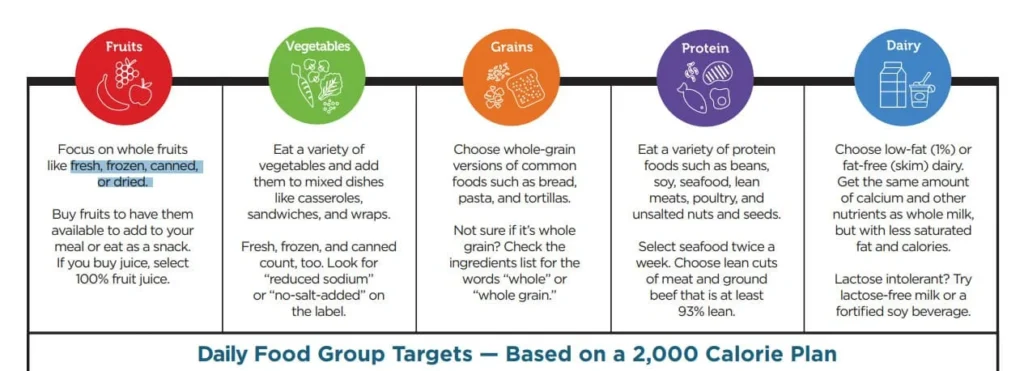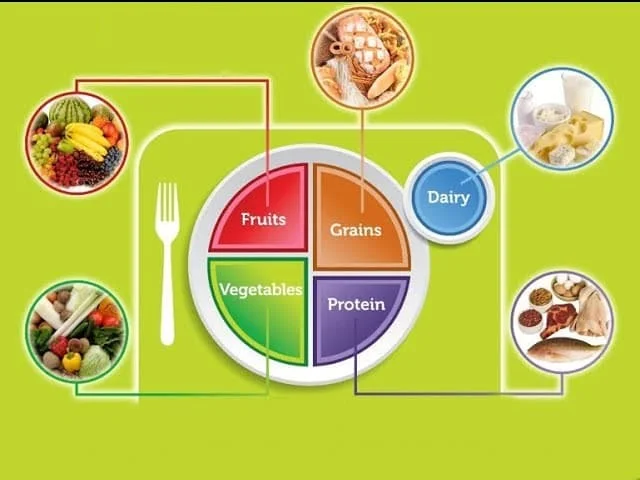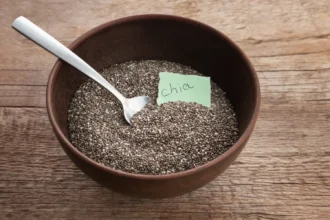Maintaining a healthy and balanced diet is key to supporting your overall health and well-being. Yet, with so much information out there, knowing where to begin can feel overwhelming. Enter Choose MyPlate, a straightforward, visual tool created by the USDA to guide you toward better eating habits. By focusing on the five essential food groups, MyPlate makes it easier to build meals that align with nutritional recommendations.
In this article, we’ll explore the core principles of MyPlate and how you can use it to make smarter, healthier food choices. You’ll also discover how following these practical guidelines can positively impact your long-term health. Ready to simplify your nutrition journey? Let’s dive in!
What is Choose MyPlate?
Choose MyPlate is a nutrition guide created by the United States Department of Agriculture (USDA) to help people make healthier, more informed food choices. Introduced in 2011 as a replacement for the Food Pyramid, MyPlate provides a practical, visual representation of a balanced meal.
The MyPlate icon is designed as a plate divided into four sections: fruits, vegetables, grains, and protein, with a smaller circle representing dairy placed alongside. This layout encourages simple yet effective dietary habits: filling half the plate with fruits and vegetables, one-quarter with grains (favoring whole grains), and the remaining quarter with lean protein sources.
Beyond the visual tool, the MyPlate initiative offers extensive online resources to support personalized dietary goals. From interactive meal planning tools to sample menus and recipes, the program makes it easier for individuals to adopt a balanced diet that prioritizes variety, portion control, and nutrient-rich options. MyPlate’s ultimate aim is to provide Americans with the knowledge and tools they need to lead healthier lives through better eating habits.
Understanding the MyPlate Food Groups
The MyPlate model highlights five essential food groups, each playing a critical role in a balanced diet. Let’s take a closer look at the key attributes of each group:

1. Fruits
Fruits are rich in vitamins, minerals, fiber, and antioxidants, supporting overall health.
- Examples: Apples, oranges, bananas, berries, melons, peaches, grapes.
- Recommended Intake: 1.5–2 cups per day for adults, depending on factors like age and activity level.
- Health Benefits: Improved digestion, reduced risk of heart disease, better weight management.
- Tips: Add fresh fruit to breakfast, pack an apple for a snack, or enjoy a fruit salad for dessert.
2. Vegetables
Vegetables, packed with nutrients, should make up a significant part of your meals.
- Examples: Spinach, broccoli, carrots, sweet potatoes, kale, peppers, tomatoes.
- Recommended Intake: 2–3 cups per day for adults.
- Health Benefits: Supports heart health, lowers blood pressure, enhances vision, and aids digestion.
- Tips: Include roasted vegetables with dinner, blend spinach into smoothies, or snack on raw carrot sticks.
3. Grains
Grains provide essential carbohydrates, energy, and fiber. Prioritize whole grains for maximum benefits.
- Examples:
- Whole Grains: Brown rice, quinoa, whole-grain bread, oats.
- Refined Grains: White rice, white bread.
- Recommended Intake: 5–8 ounce equivalents daily, with at least half from whole grains.
- Health Benefits: Reduces the risk of heart disease, supports digestion, and regulates blood sugar.
- Tips: Choose “whole grain” products and avoid refined grains when possible.
4. Protein Foods
Protein supports muscle repair and other vital functions. Opt for lean and varied sources.
- Examples:
- Animal-Based: Chicken, fish, eggs, turkey.
- Plant-Based: Lentils, beans, tofu, nuts, seeds.
- Recommended Intake: 5–6.5 ounce equivalents daily.
- Health Benefits: Builds and repairs tissues, supports metabolism, and aids in maintaining a healthy weight.
- Tips: Incorporate plant-based proteins into meals and use healthy cooking methods like grilling or steaming.
5. Dairy
Dairy provides calcium and vitamin D for strong bones and teeth.
- Examples: Milk, yogurt, cheese.
- Recommended Intake: 3 cups daily.
- Alternatives: For lactose intolerance, opt for lactose-free milk or fortified plant-based options like soy milk.
- Health Benefits: Reduces the risk of osteoporosis and strengthens bones.
Important Note: Nutritional needs vary between individuals. For personalized recommendations, consult a registered dietitian or healthcare provider.
5 Benefits of Following the Choose MyPlate Guidelines
Adopting the Choose MyPlate guidelines can lead to a healthier, more balanced lifestyle. By integrating these principles into your daily routine, you can enjoy several significant health benefits:
1. Weight Management
Filling half your plate with fruits and vegetables helps control calorie intake while providing high fiber content to keep you full and satisfied. This approach makes it easier to achieve and maintain a healthy weight without the need for restrictive dieting.
2. Reduced Risk of Chronic Diseases
A diet emphasizing fruits, vegetables, whole grains, and lean proteins—as recommended by MyPlate—can lower your risk of chronic conditions such as:
- Heart disease
- Type 2 diabetes
- Certain types of cancer
These nutrient-dense foods provide essential vitamins and minerals that support long-term health.
3. Improved Overall Health
Following the MyPlate guidelines ensures your body gets the nutrients it needs to function at its best. Benefits include:
- Increased energy levels
- Enhanced digestion
- Better sleep quality
- A stronger immune system
4. Better Mood and Cognitive Function
A well-rounded diet doesn’t just benefit your body—it also supports mental health. Proper nutrition can:
- Stabilize your mood
- Enhance mental clarity
- Improve concentration and productivity
5. Simple, Sustainable Approach
The visual simplicity of MyPlate makes it easy to implement, fostering lasting healthy eating habits without overwhelming complexity.
By following Choose MyPlate, you’re taking a meaningful step toward better overall health and a higher quality of life. It’s a practical, science-backed framework that makes nutritious eating accessible to everyone.
Tips for Implementing Choose MyPlate in Your Daily Life
Incorporating MyPlate principles into your daily routine doesn’t have to be overwhelming. By following these practical steps, you can make healthier eating a seamless habit.
Visualize MyPlate While Planning Meals
Think of your plate as a canvas for balanced nutrition:
- Fill half with colorful fruits and veggies to boost your vitamin and fiber intake.
- Reserve one-quarter for whole grains, such as brown rice or quinoa.
- Use the final quarter for lean protein, like chicken, fish, beans, or tofu.
This approach ensures your meals are well-rounded and nutrient-rich.
Swap Smartly for Better Choices
Making simple changes to your ingredients can elevate your meals:
- Opt for whole-wheat bread instead of white bread.
- Replace sugary snacks with naturally sweet fruits like berries or apples.
- Choose grilled or baked proteins over fried options to reduce unhealthy fats.
Use Nutrition Labels as Your Guide
Understanding food labels helps you make informed decisions. Look for products that are:
- High in dietary fiber.
- Low in added sugars and unhealthy fats.
- Moderately salted to avoid excess sodium.
Reading labels might take a few extra minutes, but it empowers you to choose healthier options.
Manage Portions Without Stress
Portion control is key to avoiding overeating.
- Use smaller dishes to help you serve appropriate amounts.
- Listen to your body and eat slowly, stopping when you feel satisfied.
This mindful approach not only helps with weight management but also improves digestion.
Navigate Eating Out Like a Pro
Restaurant meals don’t have to derail your healthy eating goals.
- Choose dishes with plenty of vegetables or ask for extra greens on the side.
- Request sauces and dressings on the side to control your intake.
- Swap fries for a side salad or roasted veggies whenever possible.
Dining out can still align with MyPlate principles when you make thoughtful choices.
Explore Resources for Inspiration
The MyPlate website is packed with tools to help you stay on track, including:
- Easy-to-follow recipes for every meal.
- Interactive dietary trackers to monitor your progress.
- Tips for shopping and meal prepping to simplify your routine.
Using these resources can make healthy eating more accessible and enjoyable.
Using the MyPlate Plan
The MyPlate Plan is a powerful tool that tailors nutritional recommendations to your unique needs. Here’s how you can make it work for you:
Steps to Create Your Plan
- Head to the official MyPlate website.
- Enter details like your age, weight, height, and activity level.
- Receive personalized daily goals for each food group.
Making the Most of Your Plan
- Use the plan to guide your grocery shopping and meal prep.
- Track your servings to see how closely you’re sticking to the guidelines.
- Experiment with new recipes from the website to keep your meals exciting and diverse.
Why the MyPlate Plan Works
Having a tailored plan takes the guesswork out of eating well. It helps you focus on balance and portion control, making it easier to achieve long-term health goals.
Conclusion
Choose MyPlate, created by the USDA, provides a simple yet impactful roadmap to healthier eating. By following its guidelines—filling half your plate with fruits and vegetables, dedicating a quarter to whole grains, and reserving the final quarter for lean protein while incorporating a serving of dairy—you can build a balanced and nourishing diet.
Even small adjustments, like adding more vegetables to your meals or swapping refined grains for whole ones, can lead to meaningful improvements in your overall health. Remember, adopting these principles is a journey, not a race. Start with manageable steps and gradually build on your progress.
To deepen your understanding or receive tailored dietary recommendations, explore the resources available on the official Choose MyPlate website. Begin your journey towards a healthier, more vibrant lifestyle today—because every plate is an opportunity to nourish your body and mind.
Frequently Asked Questions (FAQs)
How do I create a personalized MyPlate Plan?
Visit the official Choose MyPlate website and navigate to the “MyPlate Plan” section. By entering your age, sex, height, weight, and activity level, you’ll receive a customized plan detailing your daily intake recommendations for each food group.
Is Choose MyPlate suitable for vegetarians/vegans?
Yes, Choose MyPlate can easily accommodate vegetarian and vegan diets. The protein group includes plant-based options such as beans, lentils, tofu, and nuts. For the dairy group, fortified plant-based alternatives like soy milk or almond milk can be used.
Can Choose MyPlate help me lose weight?
Absolutely. Choose MyPlate emphasizes nutrient-dense foods like fruits, vegetables, and whole grains while encouraging portion control. This approach can naturally help you create a calorie deficit, an essential component of weight loss.
What are some examples of healthy meals based on MyPlate?
- Breakfast: Oatmeal topped with fresh berries and a sprinkle of nuts, served with a side of fortified soy milk.
- Lunch: A hearty salad with grilled chicken or chickpeas, paired with a whole-grain roll and a piece of fruit like an apple.
- Dinner: Baked salmon alongside roasted vegetables (e.g., broccoli, carrots, bell peppers) and a serving of brown rice.
How do I know if I’m getting enough of each food group?
The MyPlate Plan tool is an excellent resource for tracking your intake. Additionally, you can use the MyPlate icon as a visual guide to estimate portions and ensure balance.
Are there any criticisms of MyPlate?
While MyPlate is widely regarded as a helpful tool, some critics argue that it oversimplifies dietary guidelines or doesn’t fully differentiate between healthy and unhealthy fats or address added sugars. Despite this, it remains a highly effective starting point for promoting balanced eating habits.






